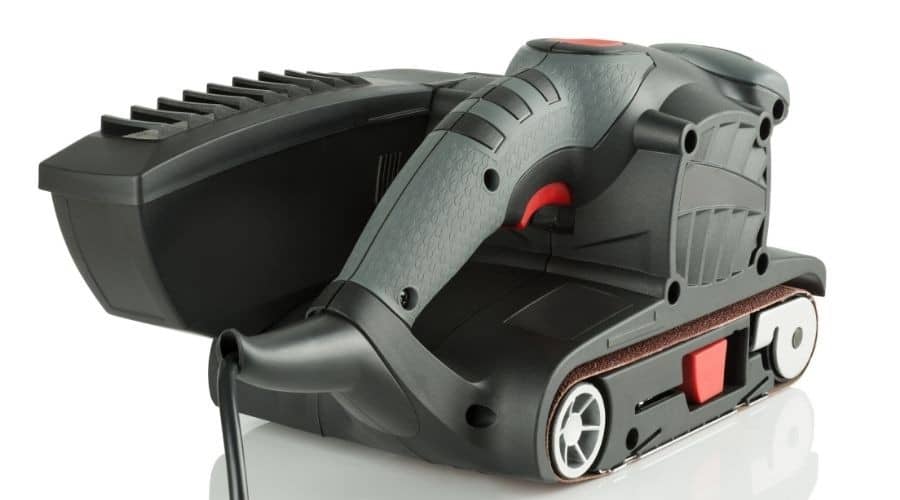Are you stuck between the difficult decision of choosing a belt sander vs a disc sander?
Well, this is a pretty common issue a lot of woodworkers face. While both perform pretty well in their distinctive roles, it’s hard to choose one without in-depth knowledge about them.
That’s why I am here to take you through all you need to know about both these sanders. Then, I will go through a little bit of comparison to give you an idea of which one you should go for.
Let’s not waste any time and get started with the whole thing.
Also read out blog :
Belt Sander

I am starting with the hand grip belt sander here. Let’s get to know all about belt sanders.
What is Belt Sanders
Belt sanders are sanders that have a pair of drums attached to them with a belt of sandpaper on. When you turn on the sander, it starts rolling the drum, which gets the belt of sandpaper rolling. As the sandpaper rolls, it starts the sanding function automatically.
A Belt Sander Is Ideal For
Usually, the primary purpose of a belt sander is to remove material. While they are small and portable sander, they can also come in larger sizes or stationary modes. They tend to have pretty good power as well. As a result, you can’t truly use them for finishing touches or are too lightweight for sanding work.
They work best for tripping edges from wood, rounding, and shaping a wood log. It also helps level wood logs you may use to make furniture. In these cases, you are mainly looking towards the material removal aspect of the belt sander, which is its ideal usage.
Belt Sander Safety Tips
You need to follow several safety measures while using a belt sander. It’s essential to follow them. Otherwise, you may damage the machine or harm yourself. Here’s what you need to maintain –
- Always try using a dust collection system. Because too much dust can be harmful to you and your surroundings.
- You must wear goggles or other eye-protection gear.
- Whenever you use the belt sander, always use it away from body motion.
- Before using your belt sander, make sure to check on the belt’s condition. A damaged or worn-out belt can be pretty lethal to work with.
- Never use one hand while you are sanding with a belt sander. It’s essential to use one hand for triggering the switch and the other hand for stability and control.
- Even when wearing work gloves, keep your hands away from the sander belt as much as possible.
- Try wearing a respiratory mask and face mask because the dust from sanding can cause a lot of damage to these parts of your body.
What Should I Check Before Using A Belt Sander?
You should always check the best condition before you use a belt sander. It’s essential to check it because a damaged and worn-out belt is pretty dangerous to work with. It can not only damage the sander but also cause serious issues with your sanding work. Operating with a damaged belt on your belt sander can be hazardous.
So, whenever you are using a belt sander, check the belt condition before using it. Don’t forget to lubricate it properly if you feel like it needs lubrication. This is the part that requires most of your attention in this machine.
Benefits and Drawbacks Belt Sander
Benefits Of Belt Sanders
- Belt sanders help in the fast and quick removal of material.
- They are great for polishing metals as well.
- You can use some belt sanders portably.
- They are great for DIY projects.
- Belt sanders are great for the versatility of work
Drawbacks Of Belt Sanders
- They aren’t the perfect pick for light sanding work.
- These aren’t suitable for professional-grade sanding.
Disc Sander

Now, let’s talk a bit about the disc sanders before we dive into comparing both the sanders.
What Are Disc Sanders?
A disc sander is the type of sander that uses a round or circular shape on the sander to sand on wood. It is usually a stationary sander. This means you can’t move around the sander too much, so you have to use cut-out wood pieces and take them to the sander to sand.
This comes with a set of different angle adjustments so you can get your desired results from the sander.
A Disc Sander Is Ideal For
Since a disc sander is stationary, it’s primarily ideal for working with wood pieces that aren’t very large. You can use the sander to smoothen any wood piece to your liking. It’s excellent for removing the upper surface, such as removing paint from wood or wastage. It also works well for sanding plastic items.
Disc Sander Safety Tips
Here are some safety rules you must maintain while using a disc sander.
- Make sure to wear all kinds of protective gear. Such as goggles, face masks, respiratory masks, and ear protection.
- Let your disc sander speed up before you start sanding on it.
- Keep your distance from the disc while the sander is running.
- Always try sanding in the downward direction from the disc.
- Use sturdy clamps to keep the disc sander consistently stable.
- Check the disc before the sanding work.
Which Side Of The Disc Sander Should You Only Sand On?
Whenever you are sanding on a disc sander, always make sure to do it in the down travel side. It’s essential to keep the workpiece in that direction and side. Otherwise, you will have inconsistencies in the sanding work.
Difference Between Belt Sander And Disc Sander
Now, let’s check out the differences between a belt sander and a disc sander to see how they compare in different aspects.
Usage Purpose
There is a pretty big difference in the usage purpose of these sanders. With a belt sander, you are mostly focusing on removing material. Also, it’s perfect for working on larger wood pieces because you can find mobile versions of this sander.
On the other hand, disc sanders are stationary, so you will need to bring your workpiece closer to the sander. Also, the sanders are good for smoothening out the wood pieces. They aren’t the best for removing material at all.
What Grit Sandpaper To Use (Belt And Disc Sander)
Typically, the range for sandpaper grit is pretty much the same for belt and disc sanders. It mostly depends on the type of job you are doing. With a belt sander, the grit can go from around 80 to somewhere around 240. As for the disc sander, it can be around 80 to 120 most of the time.
NWFA Recommendation
Usually, the NWFA recommendations for woodworking are pretty much the same for belt and disc sanders as they are quite similar in power and performance. Usually, you have to start working with 36 grit and then do a second pass with 60 and end it with 100 grit on the finishing.
These are abrasive-type sanders, so you have to make sure that you are using all the abrasive grits in the process and not leaving out anything.
Benefits and Drawbacks Disc Sander
Let’s quickly go through the benefits and drawbacks of Disc sanders.
Benefits Of Disc Sanders
- Drum sanders are great for smoothening the surface of the wood.
- It works perfectly for removing material from the surface level.
- It doesn’t damage the wood in any form, which works great for finishing touches.
- It’s much safer to use as the tool stays stable with the clamps on.
- This can give you accurate results every time.
Drawbacks Of Disc Sanders
- They aren’t very versatile in usage.
- You can’t use disc sanders portably.
Power Usage
I would say the belt sander has more power than the disc sander in terms of power usage. With a belt sander, you can remove quite a lot of material very quickly. As for disc sander, it can remove material but not at the same pace or power.
Sometimes, you may need to clear up the surfaces where the power of a disc sander shines the best. So, it depends on what your purpose is out of the sanding.
Size And Construction
The size and construction of belt sanders can be of different sizes and designs. They can be portable and stationary. At the same time, disc sanders are mostly stationary and quite large. They are also pretty heavy compared to lightweight belt sanders.
Which one To Choose For And Why
Here’s the real deal, which one you should choose between these two and why. That decision depends on the following factors. Let’s check them out one by one.
Woods Condition Which Will Be Sanding
The first thing you have to consider is the wood condition you will be working on. You can work on thin pieces of wood with a belt sander. Because it will then remove quite a lot of material, you may end up with nothing.
On the other hand, with a piece of wood that’s too thick, there is no point in using a disc sander. You can use it only when preparing the wood or finishing it.
Size And Shape Of The Would-be Sanded Wood Piece
A belt sander is an obvious way to go when you are sanding larger pieces of wood that you can’t move around. As for disc sanders, you can only use small workpieces for you to carry them to the worktable.
You can use the disc sanders to smoothen out those edges to give it an exact shape for shape. But if you want to change the shape, you have to rely on a belt sander.
Type Of Projects To Take On
Simply put, if you have a heavy-duty job where you need to remove a lot of materials, a belt sander is a way to go. Belt sanders are heavy project sanders used to accomplish mostly for furnisher sanding, floor sanding and for wooden railing . At the same time, you can rely on the disc sander for finishing or preparing wood surfaces for different purposes.
What Type Of Sanding Exactly Do You Need?
Now, this is a personal question you have to ask yourself. Which sander fulfills your needs the most. Whether you want a heavy-duty material removal sander in the form of a belt sander, or you just want to do those finishes with a disc sander is up to you.
Usually, having a belt sander works best for DIYers because it’s much more versatile. But as a professional, you may end up getting both.
Last Words
All in all, choosing between a belt sander and a disc sander can be a bit tricky. Because they almost have the same application. There are some differences, but they aren’t far from each other.
Still, if you require material removal, you go towards belt sanders. If you want to smoothen surfaces and provide a better finish on the wood, you go with disc sanders. And if you want to sand table top then go for orbital sanders. It’s as simple as that.

I am Imtiaj Islam. I am a wood working enthusiast, having 6 years of experience in carpentry work. I have a BBA graduate degree from Chittagong College. I got vocational training on wood works from Korean Polytechnic out of the quest and zest he has for carpentry as well. I take several wood projects and keep testing different woodworking tools for comfortable and perfect work. I just love playing with woods and machines.

Great article.
I was looking for some information on belt and disk sander. Perfectly got the answer.
Keep up sharing the good things.